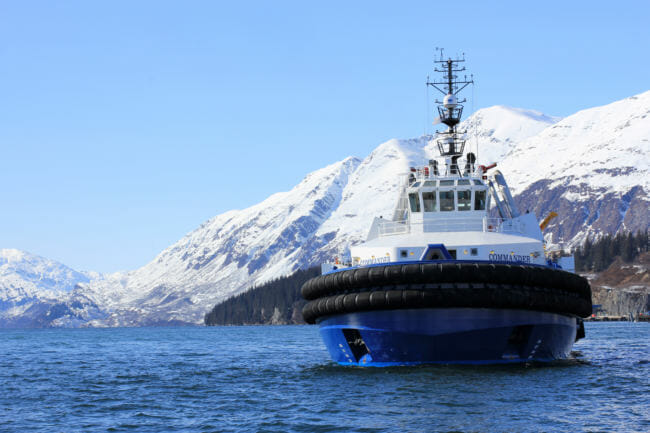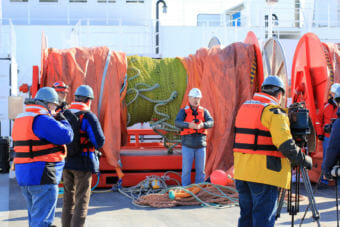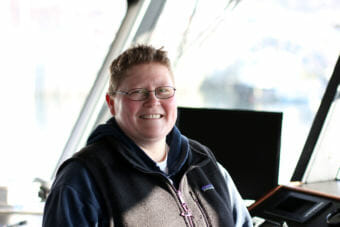
On a picture-perfect April day in Port Valdez, Alyeska Pipeline Service Company, the operator of the trans-Alaska pipeline, took a small band of reporters and camera crews on a tugboat ride.
During a spin around the Port Monday — during which reporters were encouraged to wander around, chat with the captain and take photos — Alyeska staff and the boat’s crew eagerly showed off the Commander, a sparkling new, blue tug built by the Louisiana-based company Edison Chouest Offshore.
The tugboats, barges and crews now arriving in Port Valdez are the most visible sign of a huge transition taking place in Prince William Sound. Alyeska Pipeline Service Company is bringing on Edison Chouest as a new contractor responsible for oil spill prevention and response. The switch has drawn scrutiny and criticism, so Alyeska is trying hard to reassure Alaskans that Prince William Sound — the site of the 1989 Exxon Valdez oil spill — will be safer than ever before.
Nine new tugboats like the Commander will help guide oil tankers. Four new custom-designed response barges are outfitted and crewed to respond to an oil spill.

Earlier, on board one of the new barges, Alyeska’s Mike Day guided reporters to the new oil spill cleanup equipment. Pointing at the underside of a skimmer, where there was a line of fuzzy white discs designed to collect oil, Day explained how they’re a big improvement from the old ones.
“The existing skimmers pick up about 22 percent oil and about 78 percent water, these skimmers are roughly twice that efficient,” Day said.
That theme continued throughout the tour. Alyeska and Edison Chouest staff highlighted upgrade after upgrade, from the tugboat’s more powerful engines to the toilets in the living quarters.
When it comes to the transition to Edison Chouest, that’s the message Alyeska wants to hit home: “It’s an improvement — we’re roundly convinced that it’s an improvement,” Day said.
There’s a reason Alyeska is working so hard to make this case. The contractor that Edison Chouest is replacing, Crowley Marine Services, has had a long, successful history in Prince William Sound. When Alyeska said in 2016 it was ending its contract with Crowley, it drew a lot of skepticism. Day said that’s understandable.
“We knew that this would receive a lot of scrutiny. And we welcome that,” Day said. “So no, there was no illusion that this was going to be a matter of swapping out some tugboats and some people and continuing business.”
Some of the loudest criticism has come from unions; Crowley’s workers are union members and Edison Chouest’s are not.
“It’s quite frankly a disgrace. That’s how we feel about it,” Don Marcus, president of the International Organization of Masters, Mates & Pilots, said.

Marcus branded Edison Chouest as “exceedingly anti-union;” it’s not clear if the company will hire Crowley workers once its contract ends, although the company won’t rule out the possibility.
“Edison Chouest said that they intend to hire Alaskans over time but that for mariners, they will likely draw from their existing workforce of experienced captains and crew,” Alyeska spokesperson Michelle Egan said in an email, adding, “every applicant will be considered as positions become available.”
Marcus argued that by bringing in crews new to Alaska waters, Edison Chouest is putting Prince William Sound at risk. Alyeska disagrees. It says Edison Chouest’s captains have an average of 26 years of sailing experience and that they’re undergoing extensive training to prepare for the Sound’s conditions.
But training is also an issue for another group, the Prince William Sound Regional Citizens Advisory Council (RCAC). Amanda Bauer is president of the RCAC board, and for over a decade, she’s also captained a tour boat in Valdez.
“Working in the Sound like I do, I don’t see a whole lot of winter weather, but I see enough in the fall to know what it can do, how different it can be and how even the smallest conditions — even six to nine foot seas — can sometimes be the worst,” Bauer said.
In January, the RCAC unanimously passed a resolution stating Alyeska should require Edison Chouest’s crews to train in all weather conditions they’re expected to operate in. Alyeska flatly rejected this request — its position is that training in rough weather would put crews in danger unnecessarily.
Bauer said that’s a big reason why she still has reservations.
“There’s ways to get rid of the skepticism… but until something is done in some heavy seas, I’m always going to be skeptical,” Bauer said.
Still, Bauer said she’s “cautiously optimistic” about Edison Chouest’s arrival. She said the new tugs and barges are a huge investment for Alyeska, and from her perspective, that shows commitment.
In a harbor near where Edison Chouest’s new tugs are docked, Bauer is getting her tour boats ready for the season: big, white catamarans that seat about 150 tourists. Standing by the captain’s seat, Bauer said the visitors come to see glaciers and whales.
But also, “every year, I think this is the year I’m not going to talk about the Exxon Valdez anymore — it’s been 29 years,” Bauer said. “But it’s always the first question that somebody asks when they get on the boat: ‘Where was the Exxon Valdez? What happened?’ And so we still talk about it, we still narrate the whole thing.”
“I don’t know if that’s ever going to change. I don’t know when we’ll ever get away from that,” Bauer added.
The lasting memory of the Exxon Valdez disaster is why regulators require Alyeska to put so many resources into preventing an oil spill. It’s why there are two tugboats guiding every oil tanker and it’s why barges with boom and skimmers are constantly standing by.
And it’s why Alaskans like Bauer will be watching very closely when Edison Chouest officially takes over the job on July 1.
Elizabeth Harball is a reporter with Alaska's Energy Desk, covering Alaska’s oil and gas industry and environmental policy. She is a contributor to the Energy Desk’s Midnight Oil podcast series. Before moving to Alaska in 2016, Harball worked at E&E News in Washington, D.C., where she covered federal and state climate change policy. Originally from Kalispell, Montana, Harball is a graduate of Columbia University Graduate School of Journalism.




